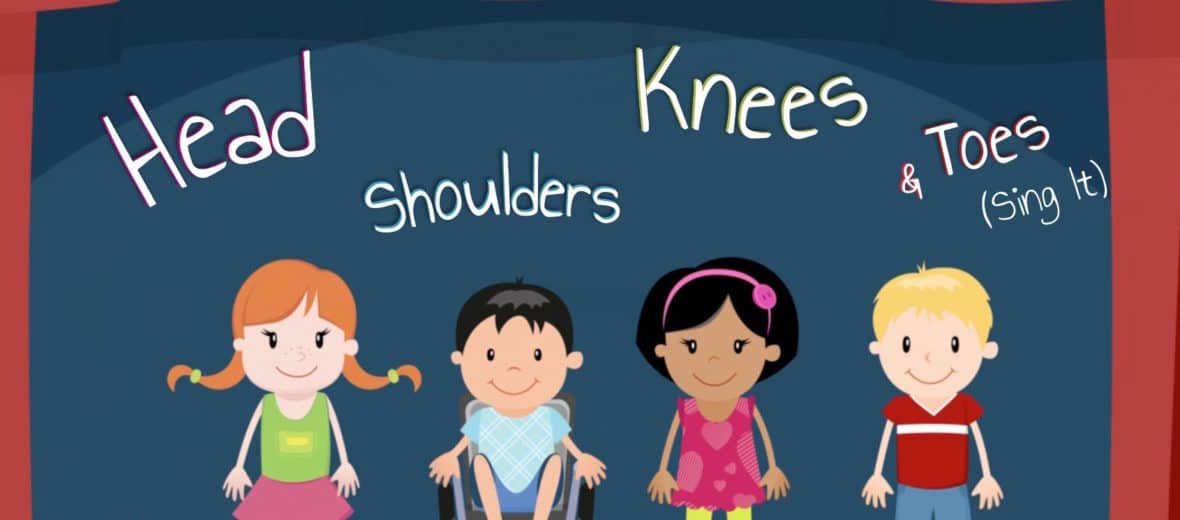
Head, Shoulders, Knees, and Toes as an ELL Tool
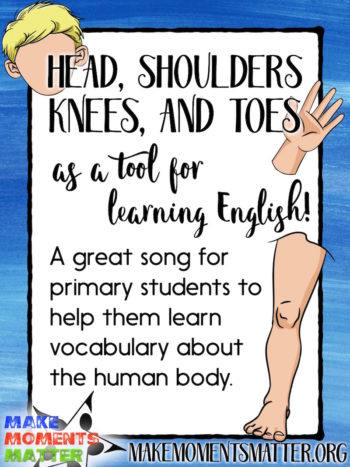 Head, Shoulders, Knees, and Toes is a classic song that many, many students learn early on in life. Lots of you folks are lucky enough to have this taught at home or in your preschools so that students come in knowing the familiar tune and words. For many teachers, teaching this song would be a review, but for me and my students it’s usually something new. My school has a mostly Hispanic population and about 70% of our students qualify for special services as they are deemed English Language Learners (ELL). In many districts this is called English as a Second Language (ESL) but since English is sometimes a third or fourth or whatever language many people term it ELL.
Head, Shoulders, Knees, and Toes is a classic song that many, many students learn early on in life. Lots of you folks are lucky enough to have this taught at home or in your preschools so that students come in knowing the familiar tune and words. For many teachers, teaching this song would be a review, but for me and my students it’s usually something new. My school has a mostly Hispanic population and about 70% of our students qualify for special services as they are deemed English Language Learners (ELL). In many districts this is called English as a Second Language (ESL) but since English is sometimes a third or fourth or whatever language many people term it ELL.
Working with English Language Learners has taught me to look for different things in even the most basic of songs and has given me some important tools for teaching that maybe I wouldn’t have discovered otherwise. “Head Shoulders” turns out to be a great beginning song for ELL students and is something that I teach to my Kindergarten friends every year in the first quarter. There are quite a few ELL/ESL strategies and lots of critical thinking questions embedded in this lesson. Here are just a few things that have become a part of my “Head Shoulders” lesson.
Teaching the Parts of the Body
I don’t take for granted that students know the correct English names for the parts of the body. We spend time at the beginning of the lesson (before I even introduce the song) going over the parts of the body. I say, “use your pointer finger to point at your knees” and then I do it to model for them. I make a big deal to show “pointer finger” and then I make a big deal to point at my “knees.” “Use your pointer finger to point at your tummy.”
Why stick to just the parts of the body that you use in the song? Go over quite a few, especially if you might use those words later in the year. I have other songs that talk about “tummy” or “belly” and so I preview those words now. “Use your pointer finger to point to your ears. Use your pointer finger to point at your nose. Use your pointer finger…” After a while my command changes from “use your pointer finger to…” to a simplified “point to your…” taking out the pointer finger part, but leaving that as an assumed part of the command.
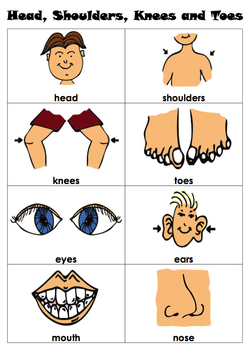 Once you’ve gone through the body parts as a class, focus in on the body parts you’re going to use in the song. Point and go through the motions with them. “Point to your head. Point to your shoulders. Knees. Toes” and then make a game out of it. “Point to your head. Your shoulders. Your toes. Your knees.” Then make them responsible for it. “I’m not going to point this time. Just you! Here we go. Head. Shoulders. Toes. Knees. Head. Knees…. Head. Shoulders. Knees. Toes. Knees. Toes.” And with that you’ve presented the pattern of the song. “Head Shoulders Knees Toes. Knees Toes. That seems like a good pattern, let’s try it again!”
Once you’ve gone through the body parts as a class, focus in on the body parts you’re going to use in the song. Point and go through the motions with them. “Point to your head. Point to your shoulders. Knees. Toes” and then make a game out of it. “Point to your head. Your shoulders. Your toes. Your knees.” Then make them responsible for it. “I’m not going to point this time. Just you! Here we go. Head. Shoulders. Toes. Knees. Head. Knees…. Head. Shoulders. Knees. Toes. Knees. Toes.” And with that you’ve presented the pattern of the song. “Head Shoulders Knees Toes. Knees Toes. That seems like a good pattern, let’s try it again!”
Once you’ve got the body parts named, the first pattern outlines, and the basic movement that goes with that pattern you’ll add in the melody. “Hey, I think I can use my singing voice to sing that pattern! Head, shoulders, knees, and toes, knees and toes!” Make sure that they’re comfortable with this pattern first, those movements, those names for the body parts. You as a teacher will want to rush ahead (it’s our natural tendency since it seems so basic, since we’ve done this song so many times, since the body part names come so naturally to us) but you really have to give them time. ELL kids need the time to process and think through the patterns.
Once they’re ready you can start in on “Eyes and ears and mouth and nose” but that gets pretty hard since it’s a new melodic pattern, new vocabulary words, and because the range of the melody goes a lot higher than usual. ELL students are generally more comfortable with mid-range melodies. They’ll go high but they won’t feel confident. Work it in in a way that eases them in. Don’t force it if they’re not ready.
A Song with a Sequence
This song is great because there are so many levels to it. Kids learn so much with such little content and that’s great! You have tons of extensions and possibilities at your fingertips! Once the kids learn the basic song with the melodic pattern and actions you’re ready to talk about the sequence. Kids easily learn that one thing follows another and with this song they learn that the actions and the body parts come in a particular order/sequence. The actions help with this as they flow from the top of the body down to the bottom.
This is a perfect opportunity to throw out some sequence words (your classroom teachers will love you for this) like first, next, then, after that, finally, etc. I sometimes quiz them and say, “So what body part comes first? And then what’s next? How about after that? What’s last?” They can also see the greater pattern. First phrase is a flow down the body. Second phrase is a flow down. Third phrase focuses on the parts of the body on your head. Last phrase flows down the body again.
Once we’ve learned the song with melody, movement pattern, sequences, and everything else we usually stop. We go over the song a couple times, work through it, and then let it sit. Kids think we’re done and they feel confident knowing the song. No worries!
Take Two – with piano… without me!
The next time I see them I pull the song out again. We sing through the whole thing slowly and remember the patterns. ELL students NEED this repetition before you do anything to change the song. The repetition with you modeling all the actions and singing all the words is important. Think about it, they might have learned new words, sang a new melody in a voice they don’t usually use (don’t assume they’ve used singing voice), learned new actions, moved in a way they don’t usually do, and have been put in charge of remembering it all in the correct sequence.
That’s a lot to remember for a non-native speaker no matter what level they’re on. And shoot, to ask that of ANY six year old is a lot, let along an English Language Learner!After we go through it all together slowly one time (or more if they need it) I change part of it up.
I put them in charge of the actions and tell them that I’ll be singing along but that I’m going to play piano. That takes away the visual of me doing it, but I still support by singing. This plays a trick on their brain because they’re in charge of the actions AND they hear a different reinforcement of the melody in the piano. I play with a loud right hand melody and minimal chordal outline in the left hand. They can’t have much more stimulus than a very easy accompaniment pattern. I go slow. We take our time.
Time to Take Things Out – “What’s Missing?”
When we’re finally ready and confident I sing a new version for them. I have them sit or stand back and JUST WATCH, no singing because the song is going to change. I switch back to modeling the singing AND showing them the actions. “Listen to how I sing it this time. HMMMMM, Shoulders, Knees and toes, knees and toes. HMMM shoulders, knees and toes, knees and toes…” and I sing through the whole song, humming instead of singing the word “Head.” Then I ask them to identify “Was something different? What word did I leave out? Did I still do the action?” Give them time to think and make their own connections and their critical thinking skills will skyrocket! They figure out what happened and then they try it with me. Humming might be new too. Don’t rush over that, take the time to let them try.
Then take out Head and Shoulders. Let them see and feel what that’s like. Then keep going. Once you’ve done a version of that, ask a question like this, “Can you figure out what body part we would take out next?” Instead of giving them the answer outright this forces them to use critical thinking to work through the sequence and figure out which word will be replaced by humming next. Keep using sequencing words like “Next, after that, then, first, second, last, finally.” Keep them thinking with “What comes next?” “What’s left?”
Once you’ve gone all the way through the song try the WHOLE THING just humming instead of singing. They’ll love that. To finish I usually go back and sing the whole song the normal way with all the words back in. It gives finality to the lesson and also let’s them go back and review and feel confident on the original song. I do the song at least one or two more times in the coming weeks so that they remember the pattern, remember the song, and understand the new concepts.
Yes, this procedure seems like it would take forever. It does. Remember, this is one of the first songs that I teach to my very young and very fresh students. At the beginning of the year all kindergarten students need repetitive songs that give them the sense of mastery. You need to go really slowly for them to understand and feel mastery before you change something, take away something, or move on to a new idea.
English Language Learners get a lot out of this song and this painfully slow process. They learn body parts, get the chance to identify them with you, and then are given the responsibility to do the actions by themselves and identify them on their own. They learn a sequence of events as they go through Head, Shoulders, Knees, and Toes. They get to modify the sequence as they replace one word and then another with humming. Even when the sequence modifies they are reinforcing the sequence because the actions stay the same (actions help them remember the actual words and help the sequence). They’re learning a new melody and are singing along with others. If you play the piano, then they’re also matching pitch with a pitched instrument and are singing along with an accompaniment. OH! And if you sit at the piano you can assess their learning by watching and listening as they sing and move without you at the front modeling.



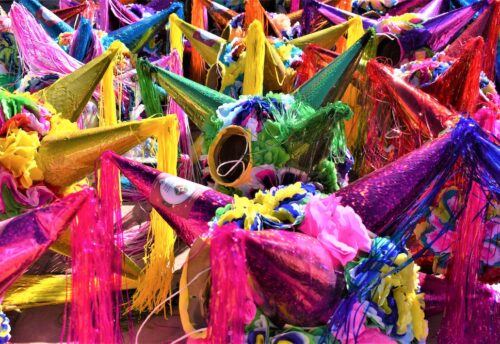
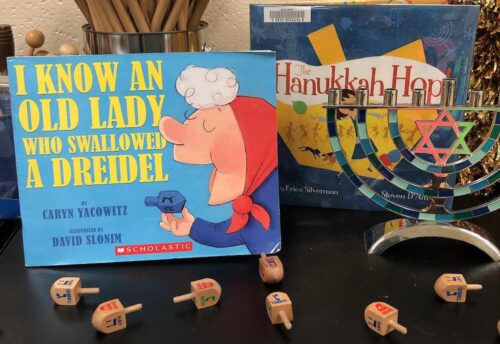
Leave a Reply